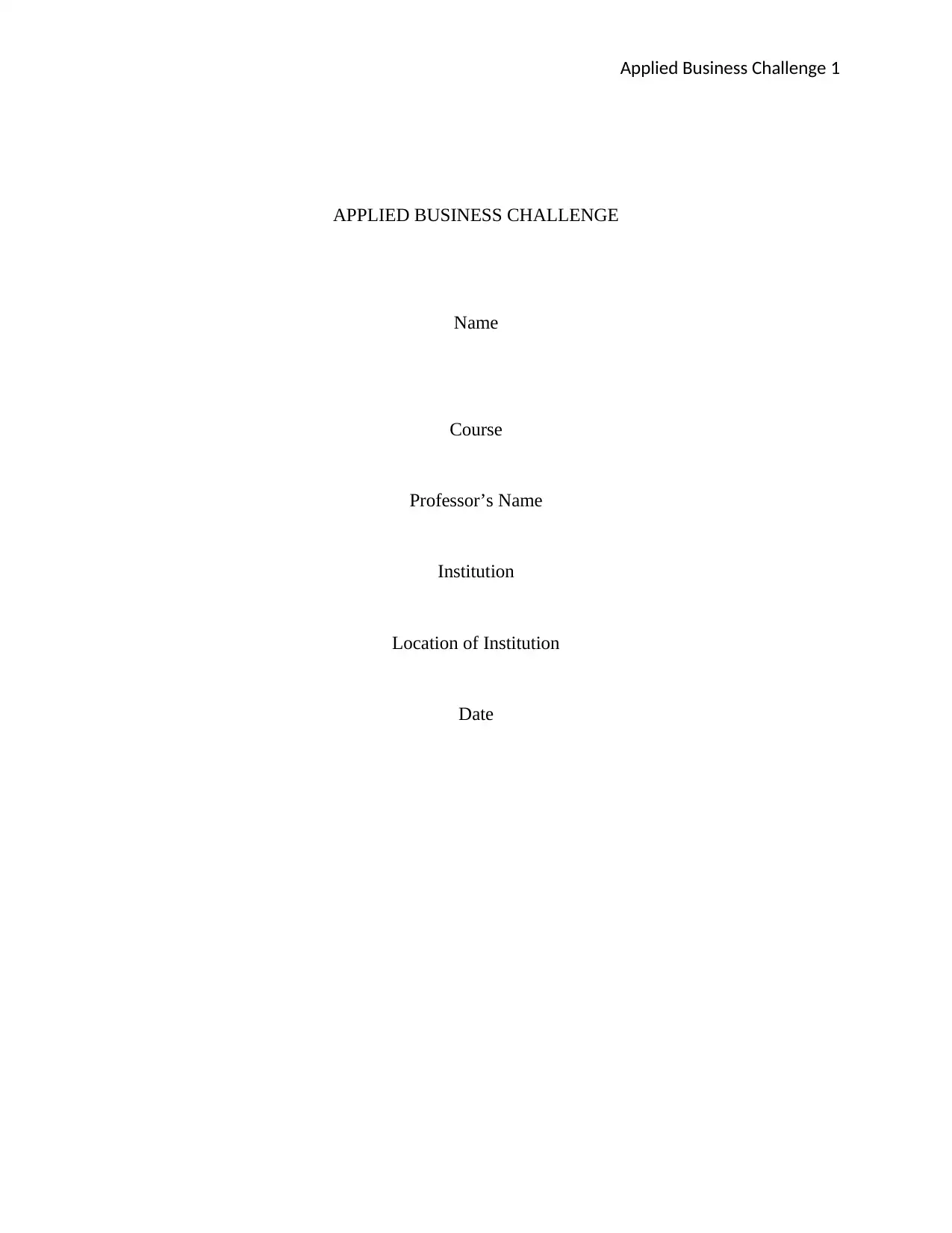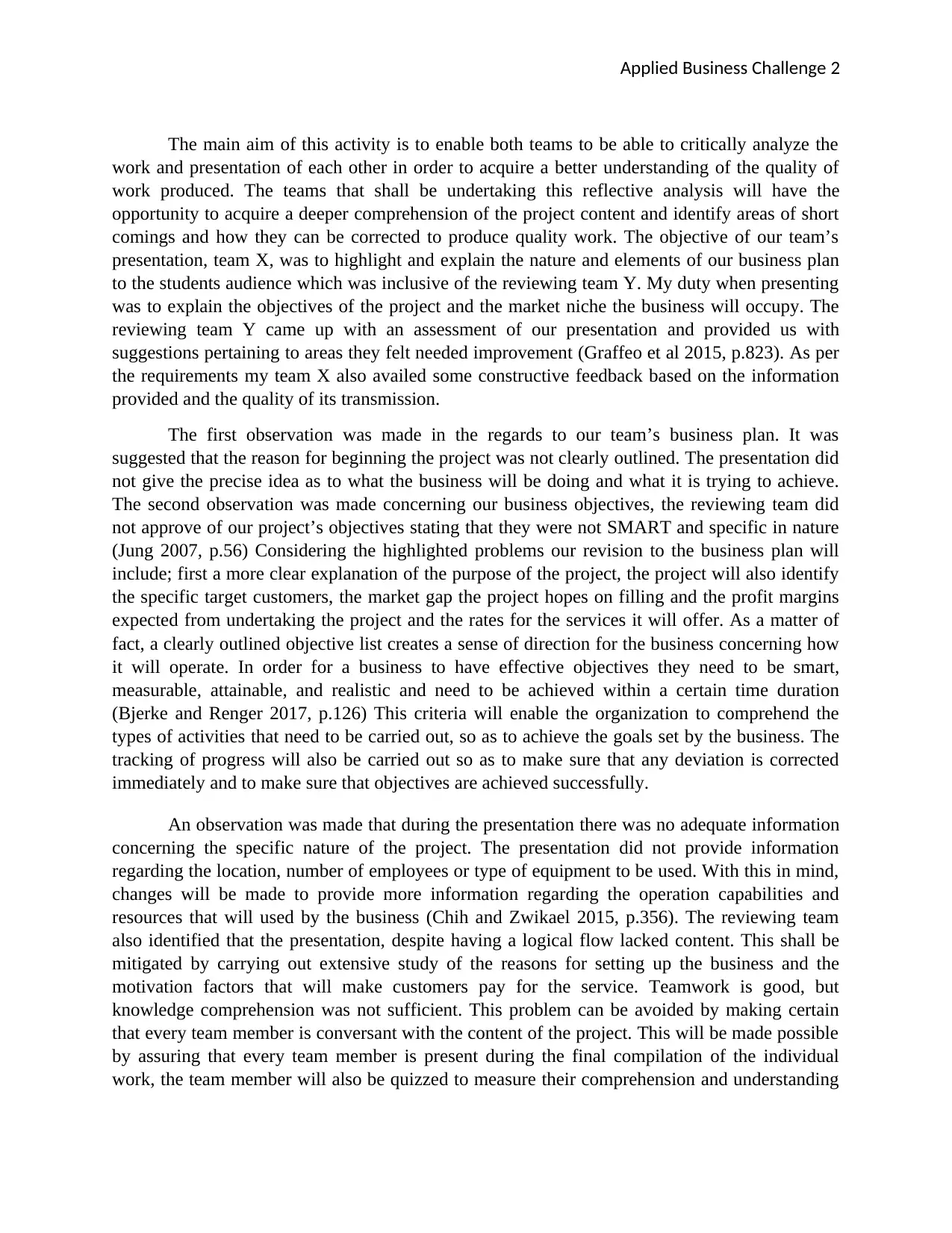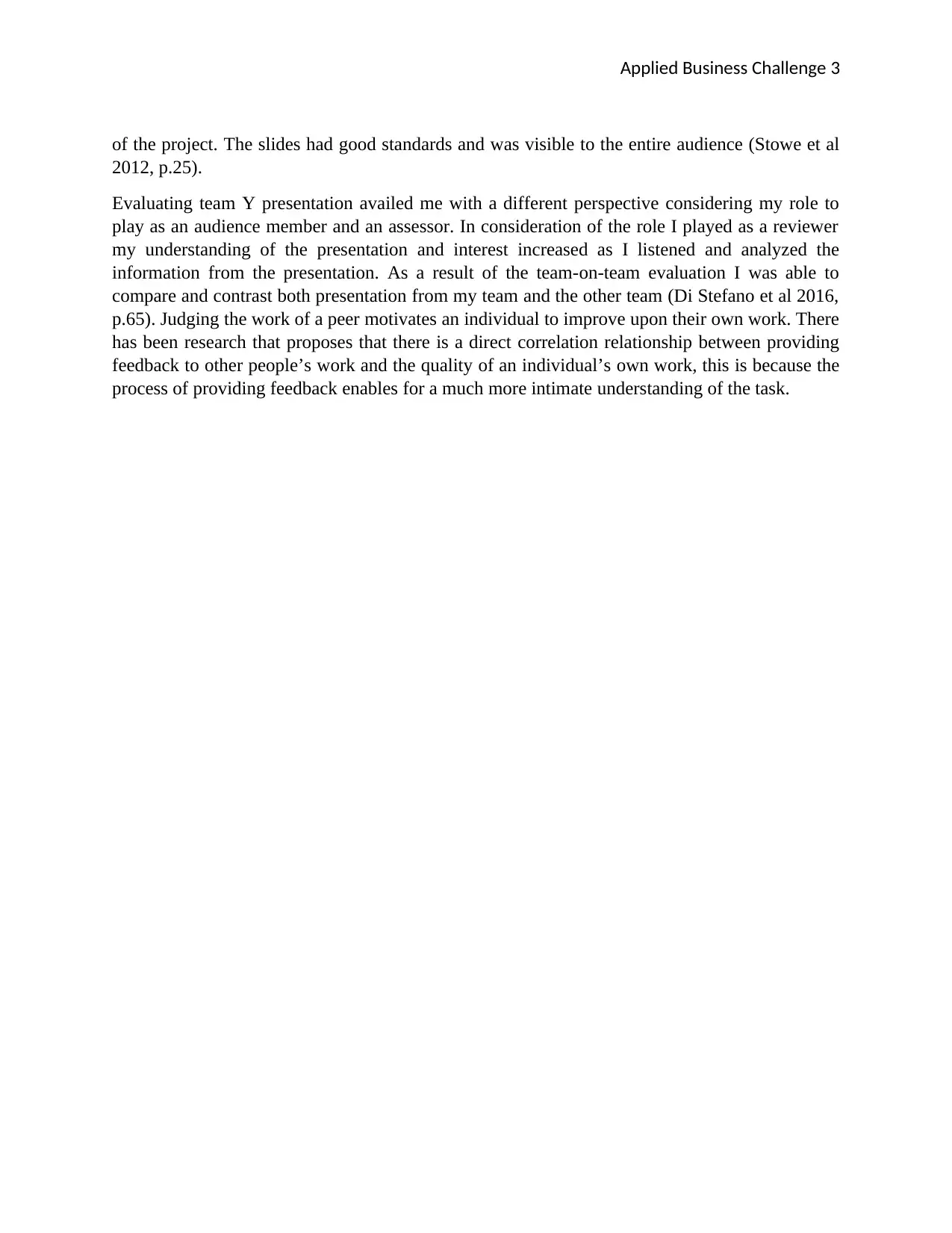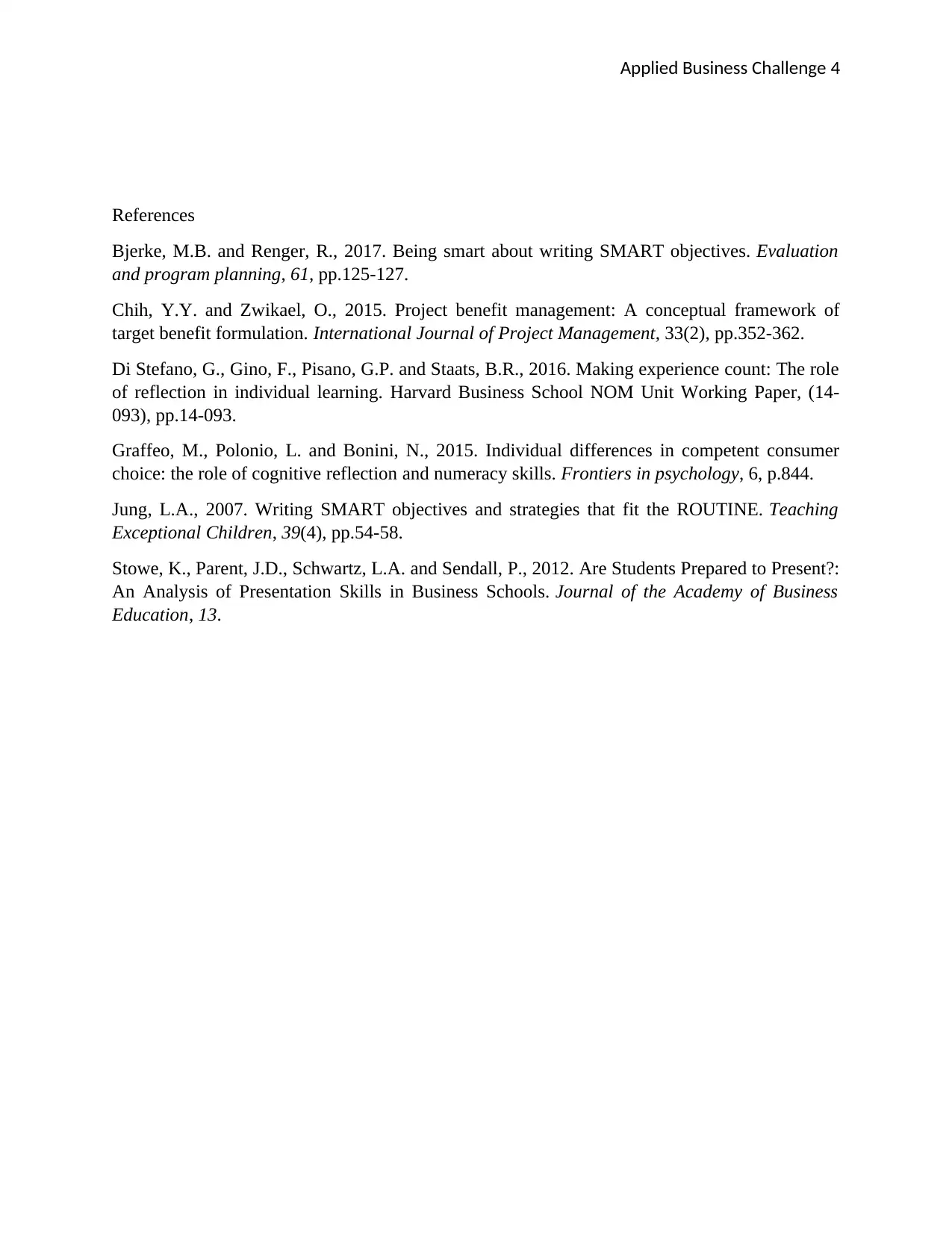Individual Reflection: Applied Business Challenge 1 Review Analysis
VerifiedAdded on 2022/12/26
|4
|1089
|33
Report
AI Summary
This report presents a student's individual reflection on an applied business challenge, specifically focusing on a team-on-team review of a business plan presentation. The student analyzes feedback received, addressing areas such as the clarity of the project's purpose, the specificity of objectives (ensuring they are SMART), and the presentation's content and visual elements. The reflection details revisions made to the business plan based on the review, including a clearer explanation of the project's goals, identification of target customers, and outlining market gaps and profit margins. The report also discusses the importance of comprehensive teamwork and knowledge comprehension among team members. The student reflects on the value of peer review in improving their own work and understanding the task more intimately. The report provides a detailed account of the review process and the improvements implemented as a result.

Applied Business Challenge 1
APPLIED BUSINESS CHALLENGE
Name
Course
Professor’s Name
Institution
Location of Institution
Date
APPLIED BUSINESS CHALLENGE
Name
Course
Professor’s Name
Institution
Location of Institution
Date
Paraphrase This Document
Need a fresh take? Get an instant paraphrase of this document with our AI Paraphraser

Applied Business Challenge 2
The main aim of this activity is to enable both teams to be able to critically analyze the
work and presentation of each other in order to acquire a better understanding of the quality of
work produced. The teams that shall be undertaking this reflective analysis will have the
opportunity to acquire a deeper comprehension of the project content and identify areas of short
comings and how they can be corrected to produce quality work. The objective of our team’s
presentation, team X, was to highlight and explain the nature and elements of our business plan
to the students audience which was inclusive of the reviewing team Y. My duty when presenting
was to explain the objectives of the project and the market niche the business will occupy. The
reviewing team Y came up with an assessment of our presentation and provided us with
suggestions pertaining to areas they felt needed improvement (Graffeo et al 2015, p.823). As per
the requirements my team X also availed some constructive feedback based on the information
provided and the quality of its transmission.
The first observation was made in the regards to our team’s business plan. It was
suggested that the reason for beginning the project was not clearly outlined. The presentation did
not give the precise idea as to what the business will be doing and what it is trying to achieve.
The second observation was made concerning our business objectives, the reviewing team did
not approve of our project’s objectives stating that they were not SMART and specific in nature
(Jung 2007, p.56) Considering the highlighted problems our revision to the business plan will
include; first a more clear explanation of the purpose of the project, the project will also identify
the specific target customers, the market gap the project hopes on filling and the profit margins
expected from undertaking the project and the rates for the services it will offer. As a matter of
fact, a clearly outlined objective list creates a sense of direction for the business concerning how
it will operate. In order for a business to have effective objectives they need to be smart,
measurable, attainable, and realistic and need to be achieved within a certain time duration
(Bjerke and Renger 2017, p.126) This criteria will enable the organization to comprehend the
types of activities that need to be carried out, so as to achieve the goals set by the business. The
tracking of progress will also be carried out so as to make sure that any deviation is corrected
immediately and to make sure that objectives are achieved successfully.
An observation was made that during the presentation there was no adequate information
concerning the specific nature of the project. The presentation did not provide information
regarding the location, number of employees or type of equipment to be used. With this in mind,
changes will be made to provide more information regarding the operation capabilities and
resources that will used by the business (Chih and Zwikael 2015, p.356). The reviewing team
also identified that the presentation, despite having a logical flow lacked content. This shall be
mitigated by carrying out extensive study of the reasons for setting up the business and the
motivation factors that will make customers pay for the service. Teamwork is good, but
knowledge comprehension was not sufficient. This problem can be avoided by making certain
that every team member is conversant with the content of the project. This will be made possible
by assuring that every team member is present during the final compilation of the individual
work, the team member will also be quizzed to measure their comprehension and understanding
The main aim of this activity is to enable both teams to be able to critically analyze the
work and presentation of each other in order to acquire a better understanding of the quality of
work produced. The teams that shall be undertaking this reflective analysis will have the
opportunity to acquire a deeper comprehension of the project content and identify areas of short
comings and how they can be corrected to produce quality work. The objective of our team’s
presentation, team X, was to highlight and explain the nature and elements of our business plan
to the students audience which was inclusive of the reviewing team Y. My duty when presenting
was to explain the objectives of the project and the market niche the business will occupy. The
reviewing team Y came up with an assessment of our presentation and provided us with
suggestions pertaining to areas they felt needed improvement (Graffeo et al 2015, p.823). As per
the requirements my team X also availed some constructive feedback based on the information
provided and the quality of its transmission.
The first observation was made in the regards to our team’s business plan. It was
suggested that the reason for beginning the project was not clearly outlined. The presentation did
not give the precise idea as to what the business will be doing and what it is trying to achieve.
The second observation was made concerning our business objectives, the reviewing team did
not approve of our project’s objectives stating that they were not SMART and specific in nature
(Jung 2007, p.56) Considering the highlighted problems our revision to the business plan will
include; first a more clear explanation of the purpose of the project, the project will also identify
the specific target customers, the market gap the project hopes on filling and the profit margins
expected from undertaking the project and the rates for the services it will offer. As a matter of
fact, a clearly outlined objective list creates a sense of direction for the business concerning how
it will operate. In order for a business to have effective objectives they need to be smart,
measurable, attainable, and realistic and need to be achieved within a certain time duration
(Bjerke and Renger 2017, p.126) This criteria will enable the organization to comprehend the
types of activities that need to be carried out, so as to achieve the goals set by the business. The
tracking of progress will also be carried out so as to make sure that any deviation is corrected
immediately and to make sure that objectives are achieved successfully.
An observation was made that during the presentation there was no adequate information
concerning the specific nature of the project. The presentation did not provide information
regarding the location, number of employees or type of equipment to be used. With this in mind,
changes will be made to provide more information regarding the operation capabilities and
resources that will used by the business (Chih and Zwikael 2015, p.356). The reviewing team
also identified that the presentation, despite having a logical flow lacked content. This shall be
mitigated by carrying out extensive study of the reasons for setting up the business and the
motivation factors that will make customers pay for the service. Teamwork is good, but
knowledge comprehension was not sufficient. This problem can be avoided by making certain
that every team member is conversant with the content of the project. This will be made possible
by assuring that every team member is present during the final compilation of the individual
work, the team member will also be quizzed to measure their comprehension and understanding

Applied Business Challenge 3
of the project. The slides had good standards and was visible to the entire audience (Stowe et al
2012, p.25).
Evaluating team Y presentation availed me with a different perspective considering my role to
play as an audience member and an assessor. In consideration of the role I played as a reviewer
my understanding of the presentation and interest increased as I listened and analyzed the
information from the presentation. As a result of the team-on-team evaluation I was able to
compare and contrast both presentation from my team and the other team (Di Stefano et al 2016,
p.65). Judging the work of a peer motivates an individual to improve upon their own work. There
has been research that proposes that there is a direct correlation relationship between providing
feedback to other people’s work and the quality of an individual’s own work, this is because the
process of providing feedback enables for a much more intimate understanding of the task.
of the project. The slides had good standards and was visible to the entire audience (Stowe et al
2012, p.25).
Evaluating team Y presentation availed me with a different perspective considering my role to
play as an audience member and an assessor. In consideration of the role I played as a reviewer
my understanding of the presentation and interest increased as I listened and analyzed the
information from the presentation. As a result of the team-on-team evaluation I was able to
compare and contrast both presentation from my team and the other team (Di Stefano et al 2016,
p.65). Judging the work of a peer motivates an individual to improve upon their own work. There
has been research that proposes that there is a direct correlation relationship between providing
feedback to other people’s work and the quality of an individual’s own work, this is because the
process of providing feedback enables for a much more intimate understanding of the task.
⊘ This is a preview!⊘
Do you want full access?
Subscribe today to unlock all pages.

Trusted by 1+ million students worldwide

Applied Business Challenge 4
References
Bjerke, M.B. and Renger, R., 2017. Being smart about writing SMART objectives. Evaluation
and program planning, 61, pp.125-127.
Chih, Y.Y. and Zwikael, O., 2015. Project benefit management: A conceptual framework of
target benefit formulation. International Journal of Project Management, 33(2), pp.352-362.
Di Stefano, G., Gino, F., Pisano, G.P. and Staats, B.R., 2016. Making experience count: The role
of reflection in individual learning. Harvard Business School NOM Unit Working Paper, (14-
093), pp.14-093.
Graffeo, M., Polonio, L. and Bonini, N., 2015. Individual differences in competent consumer
choice: the role of cognitive reflection and numeracy skills. Frontiers in psychology, 6, p.844.
Jung, L.A., 2007. Writing SMART objectives and strategies that fit the ROUTINE. Teaching
Exceptional Children, 39(4), pp.54-58.
Stowe, K., Parent, J.D., Schwartz, L.A. and Sendall, P., 2012. Are Students Prepared to Present?:
An Analysis of Presentation Skills in Business Schools. Journal of the Academy of Business
Education, 13.
References
Bjerke, M.B. and Renger, R., 2017. Being smart about writing SMART objectives. Evaluation
and program planning, 61, pp.125-127.
Chih, Y.Y. and Zwikael, O., 2015. Project benefit management: A conceptual framework of
target benefit formulation. International Journal of Project Management, 33(2), pp.352-362.
Di Stefano, G., Gino, F., Pisano, G.P. and Staats, B.R., 2016. Making experience count: The role
of reflection in individual learning. Harvard Business School NOM Unit Working Paper, (14-
093), pp.14-093.
Graffeo, M., Polonio, L. and Bonini, N., 2015. Individual differences in competent consumer
choice: the role of cognitive reflection and numeracy skills. Frontiers in psychology, 6, p.844.
Jung, L.A., 2007. Writing SMART objectives and strategies that fit the ROUTINE. Teaching
Exceptional Children, 39(4), pp.54-58.
Stowe, K., Parent, J.D., Schwartz, L.A. and Sendall, P., 2012. Are Students Prepared to Present?:
An Analysis of Presentation Skills in Business Schools. Journal of the Academy of Business
Education, 13.
1 out of 4
Related Documents
Your All-in-One AI-Powered Toolkit for Academic Success.
+13062052269
info@desklib.com
Available 24*7 on WhatsApp / Email
![[object Object]](/_next/static/media/star-bottom.7253800d.svg)
Unlock your academic potential
Copyright © 2020–2025 A2Z Services. All Rights Reserved. Developed and managed by ZUCOL.





